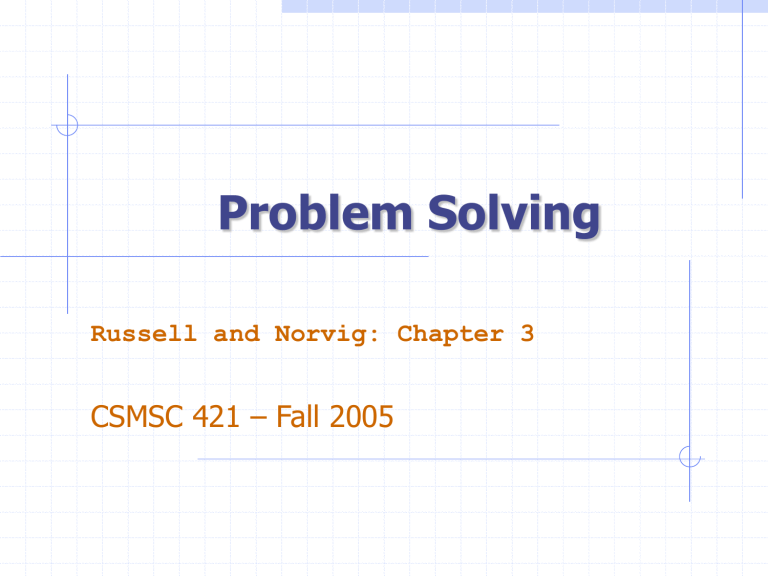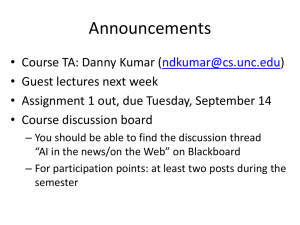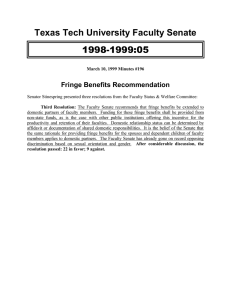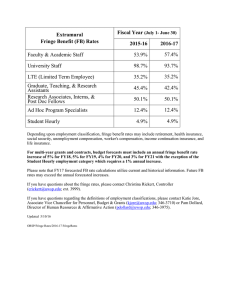Problem Solving CSMSC 421 – Fall 2005 Russell and Norvig: Chapter 3

Problem Solving
Russell and Norvig: Chapter 3
CSMSC 421 – Fall 2005
Problem-Solving Agent
sensors
?
agent actuators environment
Problem-Solving Agent sensors
?
agent environment actuators
• Formulate Goal
• Formulate Problem
•States
•Actions
• Find Solution
Example: Route finding
Holiday Planning
On holiday in Romania; Currently in Arad.
Flight leaves tomorrow from Bucharest.
Formulate Goal:
Be in Bucharest
Formulate Problem:
States: various cities
Actions: drive between cities
Find solution:
Sequence of cities: Arad, Sibiu, Fagaras, Bucharest
Problem Formulation
States
Actions
Start
Solution
Goal
Vacuum World
Search Problem
State space each state is an abstract representation of the environment the state space is discrete
Initial state
Successor function
Goal test
Path cost
Search Problem
State space
Initial state: usually the current state sometimes one or several hypothetical states (“what if …”)
Successor function
Goal test
Path cost
Search Problem
State space
Initial state
Successor function:
[state subset of states] an abstract representation of the possible actions
Goal test
Path cost
Search Problem
State space
Initial state
Successor function
Goal test: usually a condition
sometimes the description of a state
Path cost
Search Problem
State space
Initial state
Successor function
Goal test
Path cost:
[path positive number]
usually, path cost = sum of step costs e.g., number of moves of the empty tile
Example: 8-puzzle
8
5
2
3 4
1
7
6
Initial state
1 2 3
4 5 6
7 8
Goal state
Example: 8-puzzle
8
5
2
3 4
1
7
6 8
5
2
3 4
1
7
6 8
3 4
5 1
2
7
6
8
3 4
5 1
2
7
6
Example: 8-puzzle
Size of the state space = 9!/2 = 181,440
15-puzzle .65 x 10 12
0.18 sec
24-puzzle .5 x 10 25
12 billion years
6 days
10 million states/sec
Example: 8-queens
Place 8 queens in a chessboard so that no two queens are in the same row, column, or diagonal.
A solution Not a solution
Example: 8-queens
Formulation #1:
•States: any arrangement of
0 to 8 queens on the board
• Initial state: 0 queens on the board
• Successor function: add a queen in any square
• Goal test: 8 queens on the board, none attacked
64 8 states with 8 queens
Example: 8-queens
2,067 states
Formulation #2:
•States: any arrangement of k = 0 to 8 queens in the k leftmost columns with none attacked
• Initial state: 0 queens on the board
• Successor function: add a queen to any square in the leftmost empty column such that it is not attacked by any other queen
• Goal test: 8 queens on the board
Example: Robot navigation
What is the state space ?
Example: Robot navigation
Cost of one horizontal/vertical step = 1
Cost of one diagonal step = 2
Example: Robot navigation
Example: Assembly Planning
Initial state
Complex function: it must find if a collision-free merging motion exists
Successor function:
• Merge two subassemblies
Goal state
Example: Assembly Planning
Example: Assembly Planning
Assumptions in Basic Search
The environment is static
The environment is discretizable
The environment is observable
The actions are deterministic
Simple Agent Algorithm
Problem-Solving-Agent
1.
initial-state sense/read state
2.
goal select/read goal
3.
successor select/read action models
4.
problem (initial-state, goal, successor)
5.
solution search (problem)
6.
perform(solution)
Search of State Space
Search of State Space
Search State Space
Search of State Space
Search of State Space
Search of State Space
search tree
Basic Search Concepts
Search tree
Search node
Node expansion
Search strategy : At each stage it determines which node to expand
Search Nodes States
8
5
2
3 4
1
7
6
8
5
2
3 4
1
7
6
The search tree may be infinite even when the state space is finite
8
3 4
5 1
2
7
6
3
5
8 2
4 7
1 6
8
3
5
4
1
2
7
6
8
5
2
3 4
1
7
6
Node Data Structure
STATE
PARENT
ACTION
COST
DEPTH
If a state is too large, it may be preferable to only represent the initial state and (re-)generate the other states when needed
Fringe
Set of search nodes that have not been expanded yet
Implemented as a queue FRINGE
INSERT(node,FRINGE)
REMOVE(FRINGE)
The ordering of the nodes in FRINGE defines the search strategy
Search Algorithm
1.
If GOAL?(initial-state) then return initial-state
2.
INSERT(initial-node,FRINGE)
3.
Repeat:
If FRINGE is empty then return failure n REMOVE(FRINGE) s STATE( n )
For every state s’ in SUCCESSORS( s )
Create a node n’
If GOAL?( s’ ) then return path or goal state
INSERT( n’ ,FRINGE)
Search Strategies
A strategy is defined by picking the order of node expansion
Performance Measures:
Completeness – does it always find a solution if one exists?
Time complexity – number of nodes generated/expanded
Space complexity – maximum number of nodes in memory
Optimality – does it always find a least-cost solution
Time and space complexity are measured in terms of
b – maximum branching factor of the search tree d – depth of the least-cost solution m – maximum depth of the state space (may be ∞)
Remark
Some problems formulated as search problems are NP-hard problems. We cannot expect to solve such a problem in less than exponential time in the worst-case
But we can nevertheless strive to solve as many instances of the problem as possible
Blind vs. Heuristic Strategies
Blind (or uninformed ) strategies do not exploit any of the information contained in a state
Heuristic (or informed ) strategies exploits such information to assess that one node is “more promising” than another
Blind Search…
…[the ant] knew that a certain arrangement had to be made, but it could not figure out how to make it. It was like a man with a tea-cup in one hand and a sandwich in the other, who wants to light a cigarette with a match. But, where the man would invent the idea of putting down the cup and sandwich— before picking up the cigarette and the match—this ant would have put down the sandwich and picked up the match, then it would have been down with the match and up with the cigarette, then down with the cigarette and up with the sandwich, then down with the cup and up with the cigarette, until finally it had put down the sandwich and picked up the match. It was inclined to rely on a series of accidents to achieve its object. It was patient and did not think… Wart watched the arrangements with a surprise which turned into vexation and then into dislike. He felt like asking why it did not think things out in advance…
T.H. White, The Once and Future King
Blind Strategies
Breadth-first
Bidirectional
Depth-first
Depth-limited
Iterative deepening
Step cost = 1
Uniform-Cost Step cost = c(action)
> 0
Breadth-First Strategy
New nodes are inserted at the end of FRINGE
1
2 3 FRINGE = (1)
4 5 6 7
Breadth-First Strategy
New nodes are inserted at the end of FRINGE
1
2 3 FRINGE = (2, 3)
4 5 6 7
Breadth-First Strategy
New nodes are inserted at the end of FRINGE
1
2 3 FRINGE = (3, 4, 5)
4 5 6 7
Breadth-First Strategy
New nodes are inserted at the end of FRINGE
1
2 3 FRINGE = (4, 5, 6, 7)
4 5 6 7
Evaluation b : branching factor d : depth of shallowest goal node
Complete
Optimal if step cost is 1
Number of nodes generated:
1 + b + b 2 + … + b d + b(b d -1) = O(b d+1 )
Time and space complexity is O(b d+1 )
Time and Memory Requirements d
2
4
6
8
10
12
14
#Nodes Time
111
11,111
~10 6
~10 8
~10 10
~10 12
~10 14
.01 msec
1 msec
1 sec
100 sec
2.8 hours
11.6 days
3.2 years
Memory
11 Kbytes
1 Mbyte
100 Mb
10 Gbytes
1 Tbyte
100 Tbytes
10,000 Tb
Assumptions: b = 10; 1,000,000 nodes/sec; 100bytes/node
Time and Memory Requirements d
2
4
6
8
10
12
14
#Nodes Time
111
11,111
~10 6
~10 8
~10 10
~10 12
~10 14
.01 msec
1 msec
1 sec
100 sec
2.8 hours
11.6 days
3.2 years
Memory
11 Kbytes
1 Mbyte
100 Mb
10 Gbytes
1 Tbyte
100 Tbytes
10,000 Tb
Assumptions: b = 10; 1,000,000 nodes/sec; 100bytes/node
Bidirectional Strategy
2 fringe queues: FRINGE1 and FRINGE2
Time and space complexity = O(b d/2 ) << O(b d )
Depth-First Strategy
New nodes are inserted at the front of FRINGE
1
2 3
4
FRINGE = (1)
5
Depth-First Strategy
New nodes are inserted at the front of FRINGE
1
2 3
4
FRINGE = (2, 3)
5
Depth-First Strategy
New nodes are inserted at the front of FRINGE
1
2 3
4
FRINGE = (4, 5, 3)
5
Depth-First Strategy
New nodes are inserted at the front of FRINGE
1
2 3
4 5
Depth-First Strategy
New nodes are inserted at the front of FRINGE
1
2 3
4 5
Depth-First Strategy
New nodes are inserted at the front of FRINGE
1
2 3
4 5
Depth-First Strategy
New nodes are inserted at the front of FRINGE
1
2 3
4 5
Depth-First Strategy
New nodes are inserted at the front of FRINGE
1
2 3
4 5
Depth-First Strategy
New nodes are inserted at the front of FRINGE
1
2 3
4 5
Depth-First Strategy
New nodes are inserted at the front of FRINGE
1
2 3
4 5
Depth-First Strategy
New nodes are inserted at the front of FRINGE
1
2 3
4 5
Evaluation b : branching factor d : depth of shallowest goal node m : maximal depth of a leaf node
Complete only for finite search tree
Not optimal
Number of nodes generated:
1 + b + b 2 + … + b m = O(b m )
Time complexity is O(b m )
Space complexity is O(bm)
Depth-Limited Strategy
Depth-first with depth cutoff k
(maximal depth below which nodes are not expanded)
Three possible outcomes:
Solution
Failure (no solution)
Cutoff (no solution within cutoff)
Iterative Deepening Strategy
Repeat for k = 0, 1, 2, …:
Perform depth-first with depth cutoff k
Complete
Optimal if step cost =1
Time complexity is:
(d+1)(1) + db + (d-1)b 2 + … + (1) b d = O(b d )
Space complexity is: O(bd)
Comparison of Strategies
Breadth-first is complete and optimal, but has high space complexity
Depth-first is space efficient, but neither complete nor optimal
Iterative deepening is asymptotically optimal
Repeated States
No Few Many search tree is finite
1 2 3
4 5
7 8 6
8-queens assembly planning
8-puzzle and robot navigation
Avoiding Repeated States
Requires comparing state descriptions
Breadth-first strategy:
Keep track of all generated states
If the state of a new node already exists, then discard the node
Avoiding Repeated States
Depth-first strategy:
Solution 1:
Keep track of all states associated with nodes in current tree
If the state of a new node already exists, then discard the node
Avoids loops
Solution 2:
Keep track of all states generated so far
If the state of a new node has already been generated, then discard the node
Space complexity of breadth-first
Detecting Identical States
Use explicit representation of state space
Use hash-code or similar representation
Uniform-Cost Strategy
• Each step has some cost > 0 .
• The cost of the path to each fringe node N is g(N) = costs of all steps.
• The goal is to generate a solution path of minimal cost.
• The queue FRINGE is sorted in increasing cost.
A
S
1
5
B
15 C
5
10
G
5
A
1
G
11
S
0
B
5
G
10
C
15
Modified Search Algorithm
1.
INSERT(initial-node,FRINGE)
2.
Repeat:
If FRINGE is empty then return failure n REMOVE(FRINGE) s STATE( n )
If GOAL?( s ) then return path or goal state
For every state s’ in SUCCESSORS( s )
Create a node n’
INSERT( n’ ,FRINGE)
Summary
Search tree state space
Search strategies: breadth-first, depthfirst, and variants
Evaluation of strategies: completeness, optimality, time and space complexity
Avoiding repeated states
Optimal search with variable step costs




